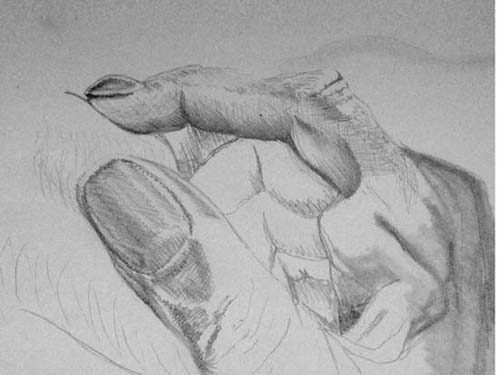I took the charcoal drawing of a 1967, Austin Healey, 3000 Mk III, sports car and super imposed it into another image of a thumb and finger, using GIMP photo editing software, I fused them together to compose the image below, about understanding perspectives and using mark making, as a visual dynamic for tricking the eye.
 In the drawing above you will see two different pencil techniques, one is called hatching and the other is called tonal modeling, both are used often, as drawing techniques for different reasons mostly. The hatching or also called cross hatching technique, is often used to draw subjects, that lend themselves to that type of mark making, like hair, grass and other textures, that can be described with lots of little lines or dashes going all in one direction or differing directions, and is a natural way to use a pencil.
In the drawing above you will see two different pencil techniques, one is called hatching and the other is called tonal modeling, both are used often, as drawing techniques for different reasons mostly. The hatching or also called cross hatching technique, is often used to draw subjects, that lend themselves to that type of mark making, like hair, grass and other textures, that can be described with lots of little lines or dashes going all in one direction or differing directions, and is a natural way to use a pencil.
The other technique is tonal modeling, which is where the pencil is smudged or modeled using graded tones, to create soft edges and shadows, most often seen in the drawing of skin tone, and clouds but in the drawing above, you will notice that both are being used in the same drawing.
The finger and thumb of the hand is drawn using hatching and cross hatching, whereas the back of the hand is drawn using a tonal modeling technique. The example is used to show how these techniques, can be used in this way and although they lend themselves to best describe textures that have been mentioned, they can also be used effectively to describe textures, that would not really lend themselves to these techniques, like with the finger and thumb.
This is also an example of how you can take already existing drawings and with photo editing software, fuse them together as a means of generating new ideas, bringing very different tools together to aid the creative process.
The image below, is almost completely created using tonal modeling and is a example of use, where it would accurately describe the fleshy textures of the baby’s skin tones, as well as, the bone textures of the skull, with the only hatching type marks, being around the word zeitgeist, which are again smudged pencil lines, with slightly modeled edges, that are not sharp or well defined. Mark making is also found in painting as well as drawing and is an important part of all kinds of art, where sometimes they are not lines, dashes or modeled areas but can be splashes, scribbles or pointillist type marks.

A hand and the artificial creations, born from its great ability, to manipulate the world around it, isn’t all intelligence artificial because we only think we know, when we recognize the mark making?
